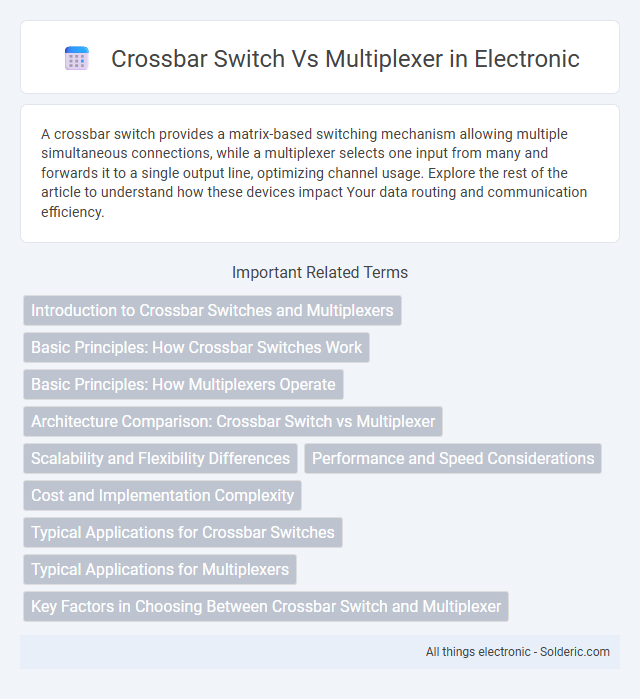A crossbar switch provides a matrix-based switching mechanism allowing multiple simultaneous connections, while a multiplexer selects one input from many and forwards it to a single output line, optimizing channel usage. Explore the rest of the article to understand how these devices impact Your data routing and communication efficiency.
Comparison Table
| Feature | Crossbar Switch | Multiplexer (MUX) |
|---|---|---|
| Definition | A matrix switch connecting multiple inputs to multiple outputs simultaneously. | A device selecting one input from multiple inputs to pass to a single output. |
| Function | Enables multiple simultaneous connections between inputs and outputs. | Selects a single data source from many inputs. |
| Number of Outputs | Multiple outputs, can connect any input to any output simultaneously. | Single output. |
| Control Inputs | Control logic enables multiple parallel paths. | Control signals select one input line. |
| Complexity | High complexity, larger size due to NxM cross-points. | Lower complexity, simpler design. |
| Use Cases | Switching centers, network routing, high-speed data communication. | Signal routing, data selectors, digital circuits. |
| Scalability | Scales with complexity, resources increase rapidly with inputs/outputs. | Scales easily by increasing input lines. |
| Latency | Low latency due to direct paths. | Depends on multiplexing speed and selection logic. |
Introduction to Crossbar Switches and Multiplexers
Crossbar switches and multiplexers are fundamental switching devices used in communication systems and digital circuits to route multiple input signals to multiple outputs efficiently. A crossbar switch consists of a matrix of intersecting horizontal and vertical lines that enable simultaneous, non-blocking connections between numerous inputs and outputs, optimizing your data path management in complex networks. Multiplexers select one input from many and forward it to a single output line based on control signals, effectively increasing channel utilization in scenarios where you need to transmit multiple signals over a single line.
Basic Principles: How Crossbar Switches Work
Crossbar switches operate by creating a matrix of intersecting horizontal and vertical lines, each intersection containing a switch that connects an input to an output. This structure allows multiple simultaneous connections, enabling direct and independent data paths between inputs and outputs without blocking. Your network benefits from low latency and high throughput, as crossbar switches eliminate contention by providing dedicated paths for each communication channel.
Basic Principles: How Multiplexers Operate
Multiplexers operate by selecting one input from multiple data lines and forwarding it to a single output based on control signals, effectively enabling resource sharing in communication systems. Unlike crossbar switches that allow simultaneous connections between multiple inputs and outputs, multiplexers focus on time or space-division to manage data flow efficiently. Your choice depends on system requirements for data routing complexity and scalability.
Architecture Comparison: Crossbar Switch vs Multiplexer
A crossbar switch architecture features a grid of intersecting horizontal and vertical lines that enable simultaneous connections between multiple inputs and outputs, offering high flexibility and parallel data paths. In contrast, a multiplexer uses a single selection line to channel one input signal to a common output, making it simpler but limited to one active connection at a time. Your choice between these architectures depends on the required complexity and the need for either concurrent data transfer or efficient single-path routing.
Scalability and Flexibility Differences
Crossbar switches offer high scalability by enabling multiple simultaneous connections through a matrix of intersecting lines, making them ideal for complex, high-throughput networks. Multiplexers provide flexibility by selectively routing multiple input signals into a single output line but are limited in scalability due to their sequential access nature. The fundamental difference lies in crossbar switches supporting parallel data paths for extensive scalability, while multiplexers prioritize signal selection efficiency with constrained expansion capabilities.
Performance and Speed Considerations
Crossbar switches provide high performance and low latency by enabling multiple simultaneous data paths, making them ideal for high-speed, parallel data transfers in complex systems. Multiplexers, while simpler and more cost-effective, operate by selecting a single input to pass to the output, which can introduce delays and reduce throughput in high-demand applications. Therefore, crossbar switches outperform multiplexers in speed-critical environments requiring concurrent data routing.
Cost and Implementation Complexity
Crossbar switches typically incur higher costs and greater implementation complexity due to their matrix-like architecture requiring numerous crosspoints, making them suitable for high-performance, large-scale networks. Multiplexers offer a more cost-effective and simpler implementation as they route multiple input signals into a single line using fewer hardware components. The trade-off involves scalability and flexibility, with crossbar switches supporting parallel connections while multiplexers handle sequential data streams efficiently.
Typical Applications for Crossbar Switches
Crossbar switches are widely used in telecommunications and network routing systems where multiple simultaneous data paths are required, such as in high-performance computing and data centers. They enable fast, non-blocking connections between numerous inputs and outputs, improving system efficiency and reducing latency. Your communication infrastructure benefits from their ability to handle complex traffic patterns without interference, unlike multiplexers that are typically used for simpler signal routing.
Typical Applications for Multiplexers
Multiplexers are typically used in communication systems to increase the efficiency of data transmission by combining multiple input signals into a single output line, enabling resource optimization in digital circuits and network routing. They are essential in data acquisition systems, allowing multiple sensor inputs to be read by a single analog-to-digital converter, reducing hardware complexity and cost. Additionally, multiplexers play a crucial role in telephone exchanges and digital signal processing, facilitating the management and switching of multiple data streams within a single channel.
Key Factors in Choosing Between Crossbar Switch and Multiplexer
Key factors in choosing between a crossbar switch and a multiplexer include scalability, complexity, and cost. Crossbar switches offer high-speed, non-blocking connectivity ideal for large, parallel data routing but involve higher hardware complexity and expense. Your decision should weigh the need for simultaneous multi-channel access with crossbar switches against the simpler, cost-effective single-channel selection provided by multiplexers.
Crossbar switch vs Multiplexer Infographic

 solderic.com
solderic.com